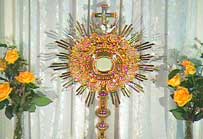 |
 
Click for live image


|
 |
1841-1926
Also known as Bartolo Longo; Bartolomea Longo; Bartolomeo Longo
di Latiano; Brother Rosary; Fratel Rosario; Herald of the Blessed
Virgin Mary's Rosary; and Man of Mary. A son of a physician, Longo
was born financially well off, and received a good education,
both secular and Christian, and attended a Piarist school until
age sixteen. Raised in a pious family, they prayed the Rosary
together each night. An excellent student, he was skilled in literature,
oratory, fencing, dancing, music, and other arts, could play flute
and piano, directed a school band; was also known to be restless,
and had difficulty sitting through classes. Studied law at the
University of Naples where received his degree in 1864, but where
he fell into a dissolute and worldly life.
Following a philosophy class taught by a fallen-away priest,
Longo moved from indifference to the Church to ridicule, to open
hostility. He participated in street demonstrations against the
Pope, then dabbled in occult nonsense like magnetism and spiritism,
tipping tables and contacting the spirit world through mediums.
Burning his bridges, he finally became a Satanist, and with some
further study, a Satanist priest.
Bartholomew's family and friends refused to give up on the young
man, praying for his return to the faith, and pecking away at
his interest in Satan. Vincente Pepe, a respected professor from
his home town, convinced him to turn from the occult, and a Dominican
friar named Father Albert guided him through his return to the
Church in a process we would today call deprogramming. Longo finally
recovered his senses and his faith, and became a Dominican tertiary
on 25 March 1871, taking the name Fratel Rosario (Brother Rosary).
Bartholomew wanted to do something to make amends for his apostasy,
and began preaching against the occult in the places where college
students frequented. Father Albert helped him join a group of
local lay people working for the poor. Seeing the terrible, grinding
poverty that was the lot of most, he wanted to do something to
help, and had a sudden inspiration that the Rosary would become
the key. He established a shrine of Our Lady of the Rosary in
the valley of Pompei and used up a discarded painting of Mary
under that title. Pilgrims came, miracles occurred, the crowds
grew, and the local bishop asked Bartholomew to construct a new
church. Work on the church began in 1876, it was dedicated in
1887, given to the papacy on 19 February 1894, was designated
a basilica in 1901 by Pope Leo XIII, and today receives about
10,000 pilgrims a day.
Bartholomew and Mariana, the widowed Countess di Fusco, constructed
other charitable institutions nearby forming what became known
as the City of Charity or City of Mary. To staff the orphanage
in the City, Longo founded the Daughters of the Rosary of Pompeii.
He established a trade school for the Sons of the Imprisoned,
boys whose fathers were in jail, and placed it under the direction
of the Brothers of Christian Schools. The success of the school
disproved the contemporary assumption that children of criminals
were doomed to be criminals themselves, and in 1922 he established
a sister school for the daughters of prisoners.
Because Bartholomew and Mariana worked together so much, gossip
developed that they were romantically involved. To prevent their
good work from being tainted by this talk, the two married in
April 1885, but lived together celibately in keeping with private
vows. It was not enough for some, however, and in the first years
of this century he was accused of adultery, profiteering, dishonesty,
even insanity. In 1906, Pope Saint Pius IX asked Longo to retire
as administrator for the good of the City, and he did, handing
it over to the papacy, and taking a job in the City as a regular
employee. Made a Knight of the Guard Cross of the Holy Sepulcher
in 1925.
|
|
 |